LAPAROSCOPIC HYSTEROPEXY/UTERINE SUSPENSION/UTERINE PRESERVATION
Dr. Miklos & Moore most commonly perform a laparoscopic hysteropexy (uterine suspension) for uterine preservation during the treatment of uterine prolapse. The technical name for hysteropexy is sacrocolpohysteropexy. To understand the procedure, it is best to first understand the definition of each of the terms which make up the name of the procedure: laparoscopic sacral colpo hystero pexy (please see the box of definitions above). If one reads the simple layman definition of the terms in the list below, from bottom to top, he or she can understand what is done during the operation: i.e. support the uterus & vaginal vault to the tailbone using mini-incisions in the belly.
DEFINITIONS OF TERMS
Laparoscopic = mini-incision in the belly
Sacral = tailbone
Colpo = vaginal vault (deepest point of vagina)
Hystero or Utero = uterus
Pexy = support
Patients have come from all over the world (50states & 54 countries) for Dr Miklos’ & Moores’ laparoscopic expertise and experience. The sacrocolpopexy with or without a uterus is considered the most successful operation for the support of the vaginal vault and/or the uterus and is routinely performed via a large incision known as a laparotomy. Dr Miklos & Moore have perfected the laparoscopic approach to the sacrocolpopexy and have performed more than 1500 laparoscopic hysteropexy / sacrocolpopexies since 1999. They continue to strive to make the uterus prolapse surgery, hysteropexy for uterus preservation even more successful as they perform these operations on a weekly basis for 20 years.
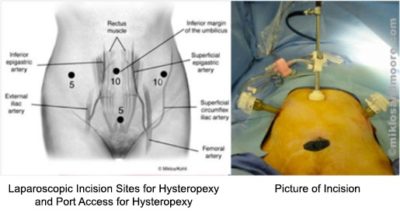
The causes of uterine prolapse are various and numerous. However, most consider childbirth to be the number one etiology or cause of the condition. It is not hard to imagine why when one considers the trauma childbirth can inflict on a woman’s body. The actual mechanism of action which results in uterine prolapse is the breaking, tearing or the stretching of the uterosacral ligaments. This is a result of damage to the nerves which innervate the muscles and over time the muscles then weaken and the uterosacral ligament gives way. These uterosacral ligaments are what normally holds the uterus in place. The uterosacral ligaments originate at the sacrum (i.e. tailbone) and insert or attach to the uterus. Interestingly when we do a sacrocolpopexy we are using mesh to mimic the pathway of the original ligaments.
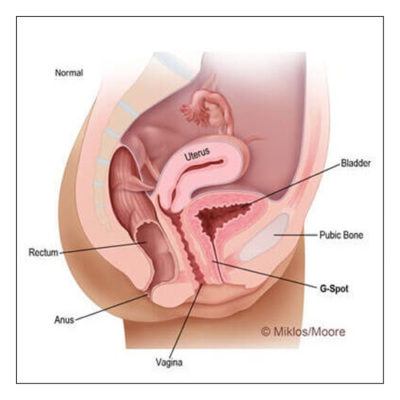
Normal Uterine Support – the uterosacral ligaments are responsible for supporting the uterus
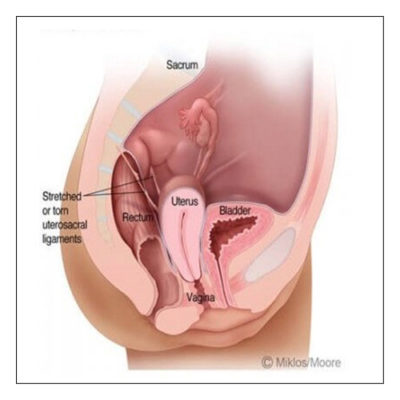
Uterine Prolapse –is a result of broken uterosacral ligaments
The laparoscopic sacrocolpohysteropexy is obviously performed though the miniature incisions above using a laparoscope and TV screens. Once the laparoscopic entry ports are placed, the skin (ie peritoneum) over the sacrum is dissected away.
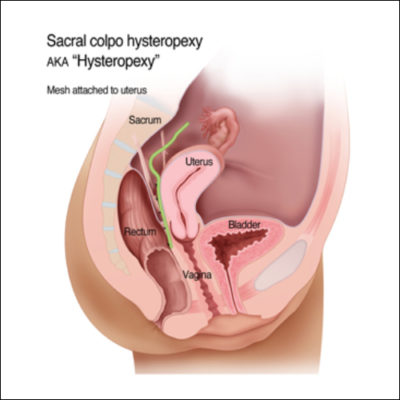 Mesh Attachment to Uterus – suturing the mesh to the posterior aspect of the uterus
Mesh Attachment to Uterus – suturing the mesh to the posterior aspect of the uterus
Once the mesh has been secured to the back of the uterus then the mesh is secured to the sacrum using the same type of permanent suture used on the back of the uterus. The sutures don’t go into the bone of the sacrum, instead the attachment is to a ligament known as the presacral ligament on the bone. After the mesh is secured to the sacrum, the mesh is covered with the peritoneal skin using an absorbable suture. This helps to prevent intestines i.e. bowel form looping around the mesh and cause a postoperative bowel obstruction.
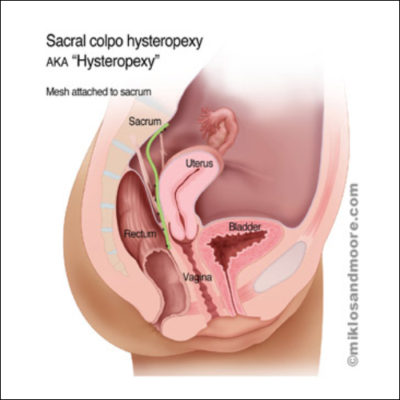
The results of repair are obvious. The mesh is now substituting for the original uterosacral ligaments, as they course the same pathway from the back of the uterus up to the tailbone. Undoubtedly the mesh is even stronger than the original ligament and it is highly unusual, if the surgery has been done correctly, that the uterus could prolapse again in the future. Sacrocolpopexy procedures in patients without a uterus in place (post hysterectomy) have cure rates of approximately >98%. The hysteropexy, uterine preservation technique, have a slightly lower cure rates of approximately >95% for uterine suspension.
The reason is simple: if the uterus is not present or the patient has had a hysterectomy, most experienced urogynecologists will use a Y-shaped mesh to attach to the apex of the vagina using two areas of attachment provide for better support and in theory a longer lasting repair. In patients opting to keep their uterus cure rates are thought to be lower because the surgeon can only attach mesh to one side of the uterus and more specifically the posterior vagina. This one-sided attachment neglects the anterior or front side of the apex of the vaginal vault. This anterior vaginal vault is neglected and is the area most vulnerable to prolapse in the future. However, Dr. Miklos & Moore always address the anterior vaginal wall by doing a paravaginal repair. The paravaginal repair is surgery for a prolapsed bladder and 99% of all patients receiving a hysteropexy need a paravaginal repair. It is their experience that anyone having a uterine suspension have a cystocele and rectocele and will need other supportive concurrent procedures such as: a paravaginal repair (to support the ceiling of the vagina and bladder), a posterior repair (to support the floor of the vagina and rectum) and or a urethral suspension procedure (to support the ceiling of the vagina and the urethra for urinary incontinence).
Dr. Miklos and Dr. Moore will perform laparoscopic uterine suspension surgery in most patients as long as the patient is an informed consumer and the preservation of the uterus is not detrimental to the health of the patient. Detrimental reasons include but may not be limited to: evidence of cancerous or precancerous conditions of the uterus, cervix, tubes or ovaries; symptomatic uterine fibroids; excessive menses; excessive pain during menses; and central chronic pelvic pain (chronic pain from the uterus). The surgeons also want to make sure the patient understands that cure rates are theoretically slightly higher if the uterus is removed and lower if the uterus remains. But for most women the tradeoff is worth it.
Dr Miklos & Moore believe in fixing all prolapsed areas concurrently in hopes of minimizing further prolapse in future. They don’t want to see a patient come back in 6 months to repair another area of the vagina which could have been fixed on her first trip to the operating room. Rest assured Dr Miklos & Moore are offering you the correct and best in uterine preservation when they do your uterine suspension by performing a laparoscopic hysteropexy.
